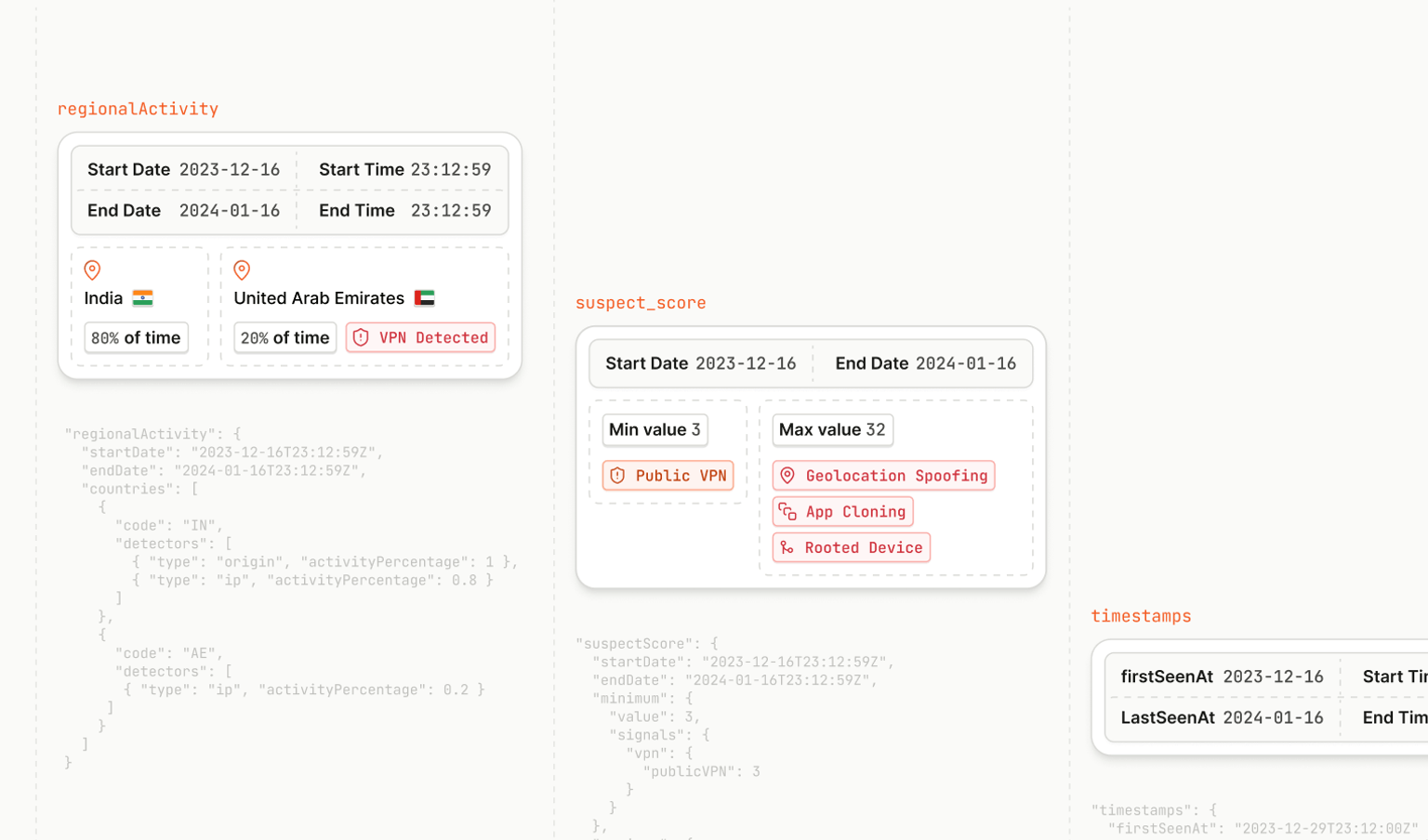
The more pieces of data you can connect, the better you'll get at spotting and stopping fraud. Each bit of information helps you see the bigger picture, like putting together a puzzle. That's why we're excited to roll out two key updates to our events Server API:
- The power to enrich past identification events with new data, giving you a more complete view of your visitors over time.
- The ability to flag suspicious behavior to give Fingerprint more data to eventually train Suspect Score weights based on individual customer use cases.
These updates boost your ability to fight fraud. You can spot potential risks with greater precision by linking more data together, even if it happened in the past, and leveraging your real-world insights in our suspect scoring. Together, you get a smarter, more adaptive shield to protect your sites and users from fraud.
Improving fraud detection with data linking
Fingerprint visitor IDs are highly accurate identifiers that uniquely recognize your web or mobile users. Linking visitor IDs with additional relevant information, like account IDs, usernames, or order numbers, is a powerful tool for detecting fraud. If you see an unfamiliar visitor ID suddenly linked to an existing account, it could mean someone unauthorized is trying to gain access. Notice multiple accounts tied to one visitor ID? That might be someone creating fake accounts, perhaps to abuse new account bonuses.
There are two ways to link visitor IDs with your own data:
- DIY approach: Manage everything in your own database and server. It's the most flexible and long-lasting but might require some changes to your backend.
- Easy mode: Use our Fingerprint API right from the client side. It's quick to set up and simple to use. Just send the extra data when you're identifying a visitor, like this:
const fpPromise = import("https://fpjscdn.net/v3/your-public-api-key")
.then(FingerprintJS => FingerprintJS.load());
// Pass your own data to get()
fpPromise
.then((fp) =>
fp.get({
linkedId: "accountNum12345",
tag: {
orders: ["orderNum6789"],
location: { city: "Atlanta", country: "US" },
},
})
)
.then((result) => console.log(result.visitorId));New update capability for past events
Now, here's how we've made things even better. Before, if you were using our API to store linked data, you could only add information at the moment of identification from the client. Any information you learned later about the visitor or information from your backend could not be appended to past identification events. This was especially limiting for those early visits before a user could be linked to specific account information. It hindered the depth of analysis you could do of the data collected through our APIs.
To increase our APIs' flexibility, we’ve introduced a new PUT method for the Events API. This method allows you to add or modify information on past identification events. You can now update linked data when new details come to light.
Here's how it works:
->
PUT /events/<request_id>
{
"linkedId": "something",
"tag": {"eventType": "login"}
}
---
<- 200 OKNote that updates can only be made to events that occurred within the last 10 days. While each PUT request does not require all available high-level attributes, an updated tag object will overwrite the current object.
Imagine a visitor browsing your site anonymously, then signing up or making a purchase later. Now, you can link their previous anonymous events to their new customer profile with a simple PUT request. This not only enhances personalization but also boosts your fraud detection capabilities.
Let's say that the same visitor showed some red flags before signing up, like multiple failed login attempts or suspicious browsing patterns. Once you know their account information, you can tag those past events, potentially uncovering fraudulent behavior that might have slipped through the cracks. This new flexibility means you can build a more complete, dynamic picture of each visitor and their activity over time.
Flagging events with suspicious activity
The other addition we’re introducing is around flagging and identifying suspicious events. Today, our Suspect Score identifies potential malicious activity based on statistically unusual patterns, but we think there is an opportunity to make it even more relevant to your specific environment.
With our latest update, you can start flagging identification events as suspicious. This new suspect flag goes hand in hand with our first update, allowing for suspicious activity flagging on current or past events. For example:
->
PUT /events/<request_id>
{
"suspect": true
}
---
<- 200 OKThis new flag is the first of many steps to incorporate real data from your site and capture the nuances of your specific fraud patterns. In the future, once an event is flagged, we will use that information to refine our models and tailor your Suspect Scores to reflect the actual suspicious behaviors you are experiencing.
As you contribute more real-time data, we can recognize patterns that are particularly problematic for your business. This results in a more personalized and effective fraud prevention solution.
For now, we are starting with event flagging, and we plan to work closely with our customers to expand our available Dashboard analytics and refine our Suspect Score calculations. We will start working with individual customers who have contributed enough data to refine their individual Suspect Score weights. Interested in helping us shape the future of this feature? Submit an insight to our roadmap or reach out to petr.palata@fingerprint.com to learn more!
Putting the pieces together
The two latest updates to our Server API allow you to combine more pieces of data to improve your fraud prevention. You can now enrich past identification events with new information, building a more comprehensive profile of your visitors over time. And soon, you will be able to influence our Suspect Score by flagging fraudulent events and tailoring our analysis to your specific environment.
These improvements enable you to create a more dynamic and personalized fraud detection strategy. By leveraging your data and Fingerprint’s new flexibility, you can better protect your business from evolving fraud tactics.
We're committed to continually providing the best device intelligence platform to meet your needs. Contact our team to learn more about Fingerprint or how these updates can strengthen your fraud prevention efforts.
FAQ
You can access the new data linking and fraud flagging features using the Fingerprint Server API. Specifically, the Events API takes a requestId and data to associate with the event, such as a username or other relevant information.
The same restrictions on linkedId and tag remain. The linkedId must be a string value, and the tag data must be limited to a 16kb JSON object. Additionally, the API is restricted to updating only events up to 10 days old.
Suspect Score and the new ability to flag fraudulent events are available on Pro Plus and Enterprise plans.



